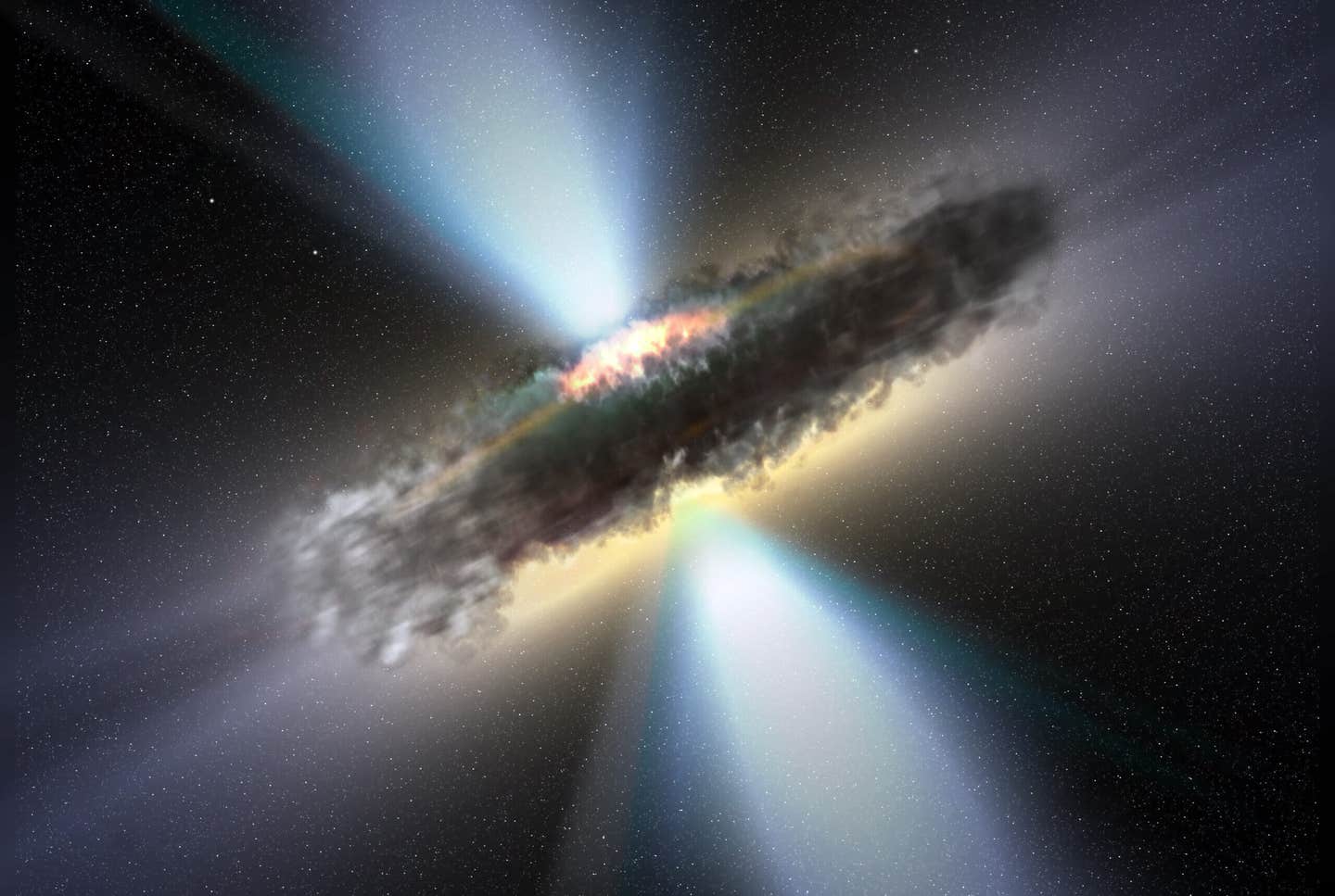Astronomers find the largest water reservoir in the universe – 140 trillion times more water than on Earth
This immense collection of water, equivalent to 140 trillion times the water in Earth’s oceans, surrounds a quasar over 12 billion light-years away.

An artist’s concept depicting a quasar, or consuming black hole, similar to APM 08729+5255. (CREDIT: NASA / ESA)
Astronomers have identified the largest and most distant water reservoir ever detected in the universe. This immense collection of water, equivalent to 140 trillion times the water in Earth's oceans, surrounds a quasar over 12 billion light-years away.
"The environment around this quasar is very unique in that it's producing this huge mass of water," stated Matt Bradford from NASA's Jet Propulsion Laboratory. "It's another demonstration that water is pervasive throughout the universe, even at the very earliest times." Bradford leads one of the teams behind this groundbreaking discovery. Their research, partially funded by NASA, appears in the Astrophysical Journal Letters.
Quasars are powered by enormous black holes that consume surrounding gas and dust, emitting vast amounts of energy. The quasar in question, APM 08279+5255, harbors a black hole 20 billion times more massive than the sun and produces energy equivalent to a thousand trillion suns.
Although astronomers anticipated finding water vapor in the distant universe, detecting it this far away is unprecedented. The Milky Way contains water vapor, but in significantly smaller amounts—4,000 times less than that found in the quasar, as most of our galaxy's water is frozen in ice.
Water vapor acts as a crucial trace gas, revealing much about the quasar. In APM 08279+5255, the water vapor is spread across a gaseous region hundreds of light-years wide. This indicates that the quasar bathes the gas in X-rays and infrared radiation, making the gas unusually warm and dense by astronomical standards. While the gas temperature is a frigid minus 63 degrees Fahrenheit, it is still five times hotter and 10 to 100 times denser than typical galactic environments.
Measurements of water vapor and other molecules, like carbon monoxide, suggest there is enough gas to fuel the black hole until it grows sixfold. However, the future of this gas remains uncertain; it could condense into stars or be expelled from the quasar.
Bradford's team began their observations in 2008 using "Z-Spec" at the California Institute of Technology's Submillimeter Observatory, a 33-foot telescope on Mauna Kea, Hawaii. Follow-up observations were conducted with the Combined Array for Research in Millimeter-Wave Astronomy (CARMA) in Southern California's Inyo Mountains.
The second team, led by Dariusz Lis of Caltech, used the Plateau de Bure Interferometer in the French Alps. In 2010, Lis's group accidentally detected water in APM 8279+5255. Bradford's team provided further details about the water's massive quantity by detecting multiple spectral signatures.
Contributing authors to Bradford's paper, "The water vapor spectrum of APM 08279+5255," include Hien Nguyen, Jamie Bock, Jonas Zmuidzinas, and Bret Naylor of JPL; Alberto Bolatto from the University of Maryland; Phillip Maloney, Jason Glenn, and Julia Kamenetzky of the University of Colorado; James Aguirre, Roxana Lupu, and Kimberly Scott from the University of Pennsylvania; Hideo Matsuhara of the Institute of Space and Astronautical Science in Japan; and Eric Murphy of the Carnegie Institute of Science.
Other sources of water in the universe
Interstellar Clouds (Molecular Clouds): These are vast regions of gas and dust in space where stars are born. Water exists in the form of ice on dust grains and as water vapor within these clouds.
One well-known interstellar cloud where scientists have found water is the Orion Nebula (Messier 42 or M42). The Orion Nebula is a massive star-forming region located about 1,344 light-years away from Earth. Observations using various telescopes, including the Herschel Space Observatory, have detected water in the form of both ice and vapor within this nebula.
The Herschel Space Observatory, in particular, has identified water vapor in the warm gas surrounding newly formed stars in the Orion Nebula, providing insights into the processes that lead to the formation of water in interstellar space.
Protoplanetary Disks: These are disks of gas and dust that surround young stars and eventually form planets. Water ice is commonly found in these disks and can be incorporated into forming planets and other celestial bodies.
One notable protoplanetary disk where scientists have found water is around the young star PDS 70. This star system, located about 370 light-years away from Earth in the constellation Centaurus, has been extensively studied due to its two forming planets and the presence of water in its protoplanetary disk. Observations made using the Atacama Large Millimeter/submillimeter Array (ALMA) detected water vapor within the disk, providing crucial insights into the processes of planet formation and the distribution of water in young planetary systems.
Comets: These icy bodies originate from the outer regions of planetary systems, such as the Kuiper Belt and the Oort Cloud in our solar system. Comets are rich in water ice, which sublimates (turns into gas) when they approach the Sun, creating their characteristic tails.
Scientists have found water on several comets, with one of the most notable examples being Comet 67P/Churyumov-Gerasimenko. The European Space Agency's Rosetta mission, which included the Philae lander, made significant discoveries about the composition of this comet, including the presence of water.
The Rosetta spacecraft detected water vapor being released from the comet's nucleus as it approached the Sun. The mission provided detailed measurements of the water content and other volatile substances on Comet 67P/Churyumov-Gerasimenko, enhancing our understanding of the role comets play in delivering water to planetary bodies.
Another example is Comet Hartley 2 (103P/Hartley). Observations by NASA's EPOXI mission revealed that the water in this comet has a similar isotopic composition to Earth's oceans, suggesting that comets like Hartley 2 could have contributed to the delivery of water to Earth.
Asteroids: Some asteroids, particularly those in the outer regions of the asteroid belt, contain significant amounts of water in the form of hydrated minerals or ice.
One of the asteroids where scientists have found water is Ceres, the largest object in the asteroid belt between Mars and Jupiter. NASA's Dawn mission, which orbited Ceres from 2015 to 2018, detected water vapor on Ceres. The spacecraft found that the surface of Ceres has a significant amount of water ice and identified evidence of a subsurface ocean, making it a key object of interest in the study of water in the solar system .
Planetary Atmospheres and Surfaces: Planets and moons, especially those in the habitable zones around their stars, can have substantial amounts of water. Earth is a prime example, with abundant liquid water on its surface. Other bodies, like Europa (a moon of Jupiter) and Enceladus (a moon of Saturn), have subsurface oceans beneath their icy crusts.
Exoplanets: Water has been detected in the atmospheres of some exoplanets (planets outside our solar system). These detections are often made using spectroscopy, which can identify water vapor by its unique absorption lines in the light spectrum.
One notable exoplanet where scientists have found water is K2-18b. Located about 124 light-years away in the constellation Leo, K2-18b is a super-Earth that orbits within the habitable zone of its star. In 2019, scientists detected water vapor in the atmosphere of K2-18b using data from the Hubble Space Telescope. This discovery marked the first time water had been identified in the atmosphere of an exoplanet within the habitable zone, where conditions might be right for liquid water to exist on the surface .
Water in the universe is primarily formed through chemical reactions between hydrogen and oxygen, the two most abundant elements. In the cold environments of space, these reactions can lead to the formation of water ice on dust grains, which then coalesce to form larger bodies containing water.
Note: Materials provided above by the The Brighter Side of News. Content may be edited for style and length.
Like these kind of feel good stories? Get the Brighter Side of News' newsletter.
Joshua Shavit
Science & Technology Writer | AI and Robotics Reporter
Joshua Shavit is a Los Angeles-based science and technology writer with a passion for exploring the breakthroughs shaping the future. As a contributor to The Brighter Side of News, he focuses on positive and transformative advancements in AI, technology, physics, engineering, robotics and space science. Joshua is currently working towards a Bachelor of Science in Business Administration at the University of California, Berkeley. He combines his academic background with a talent for storytelling, making complex scientific discoveries engaging and accessible. His work highlights the innovators behind the ideas, bringing readers closer to the people driving progress.



